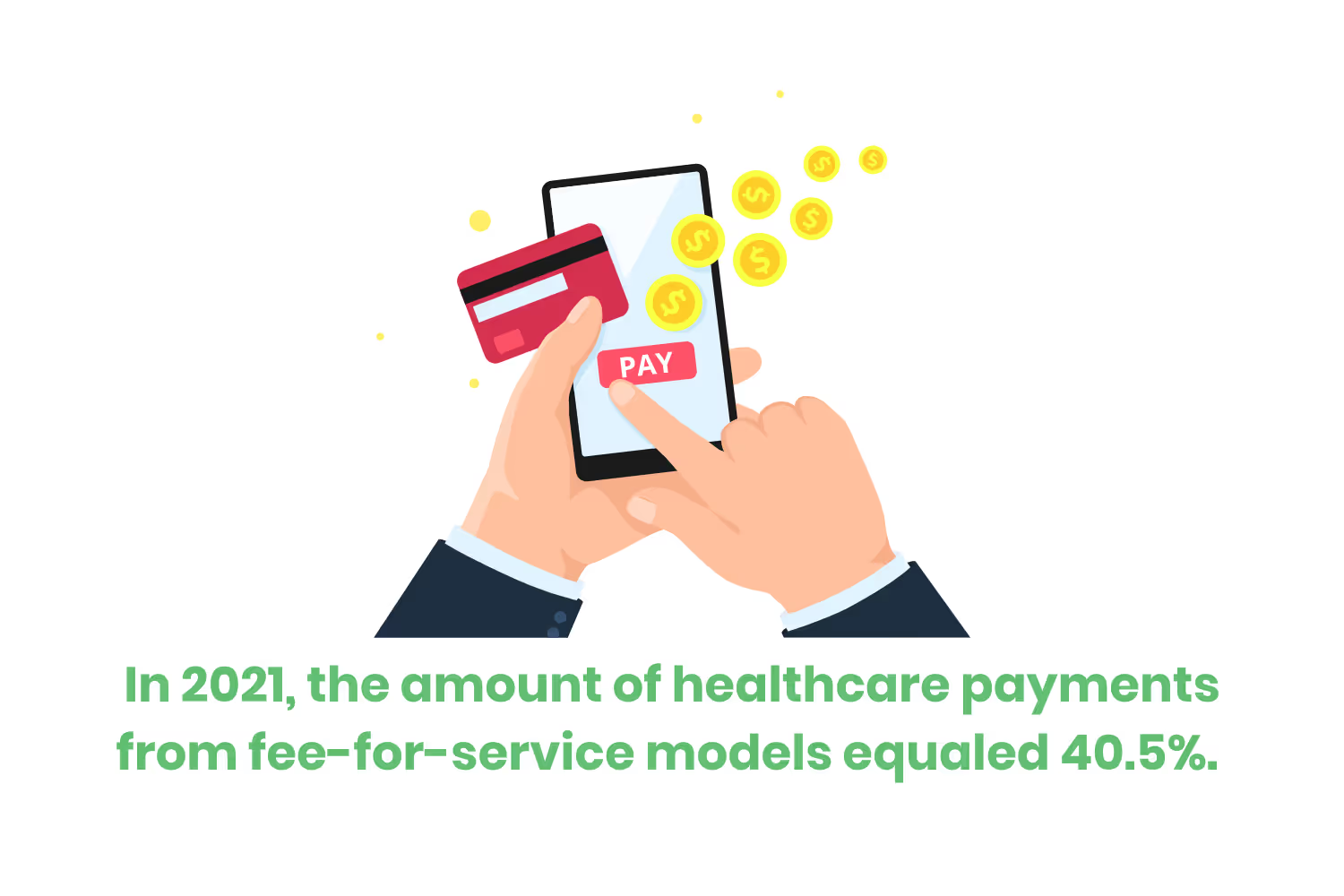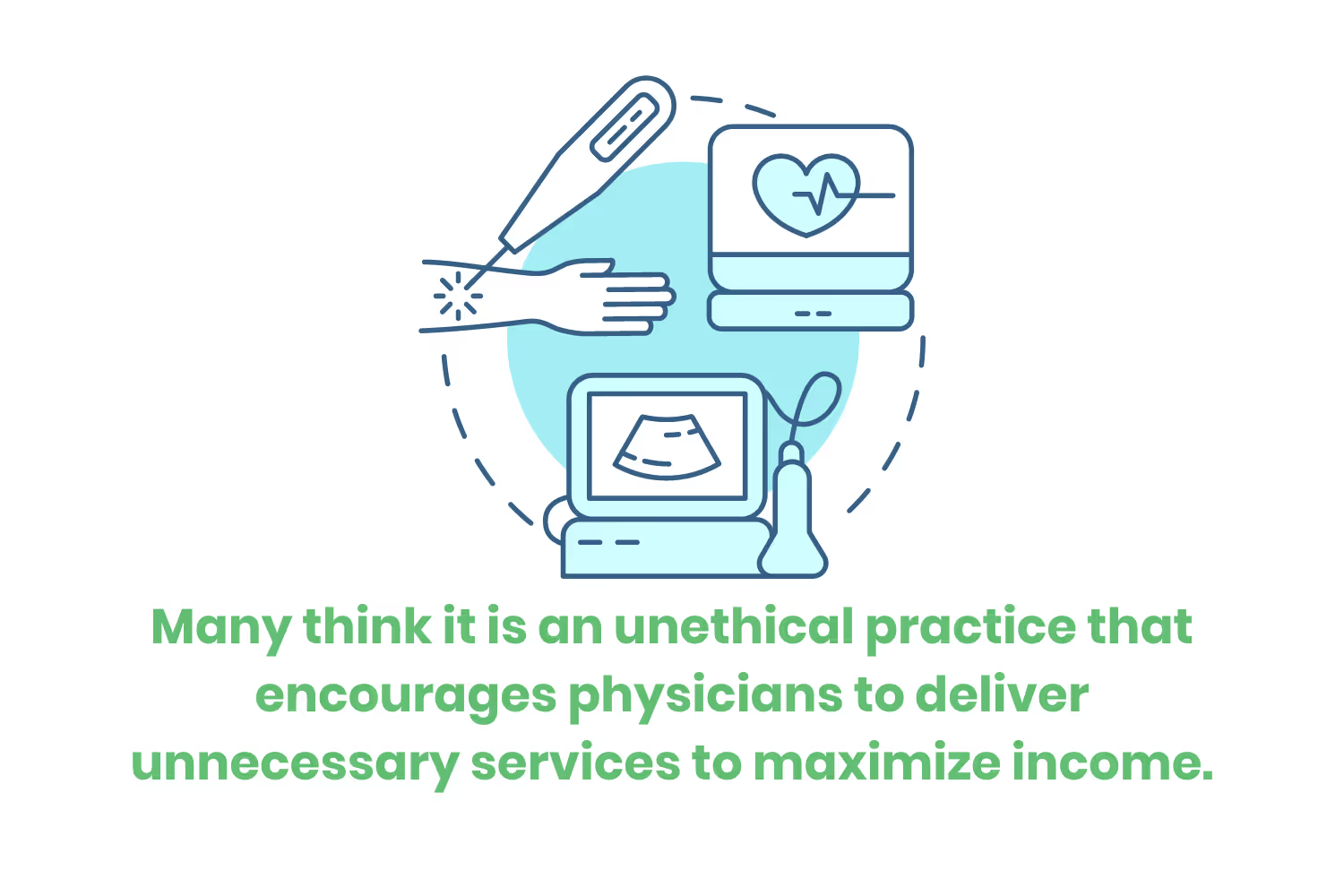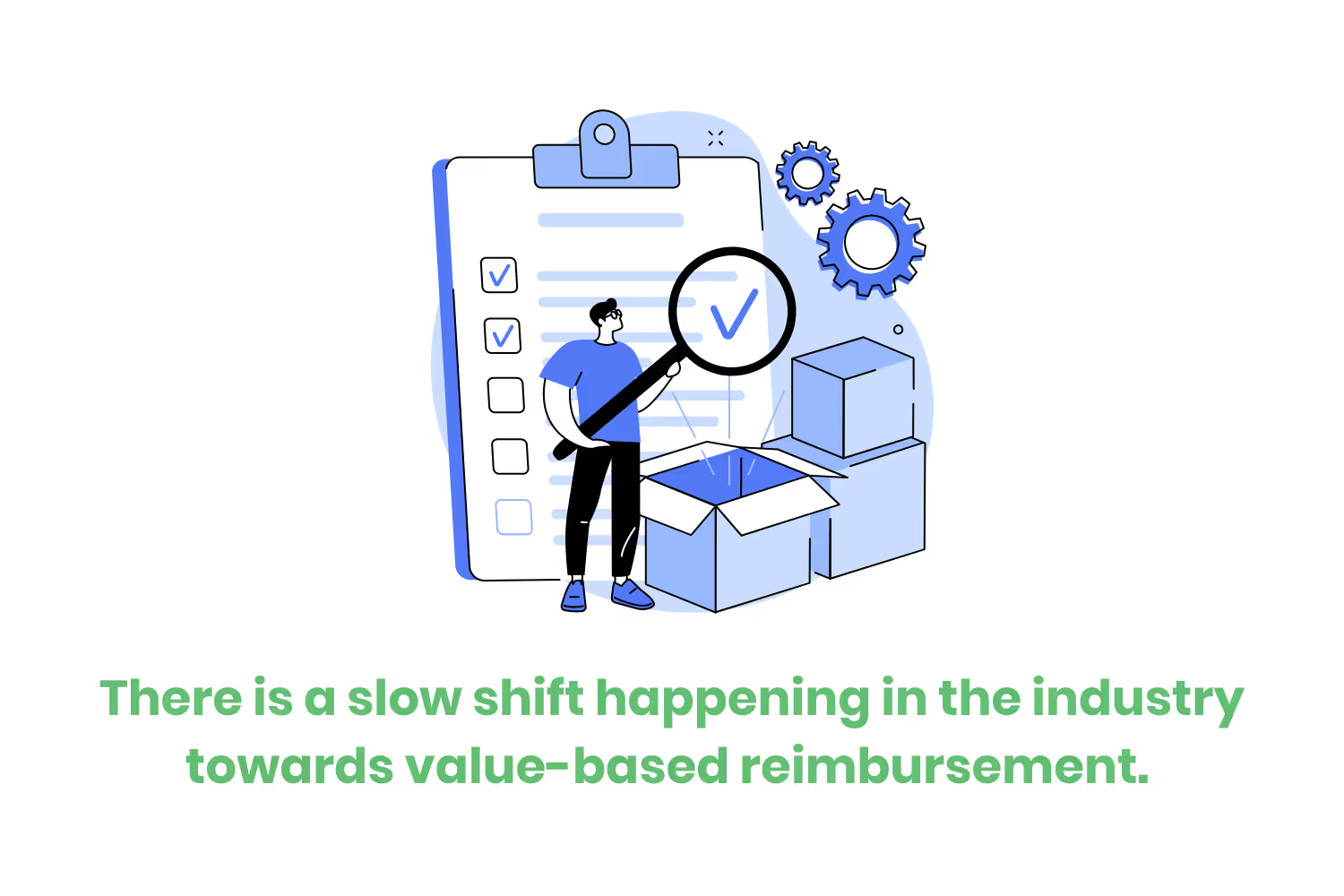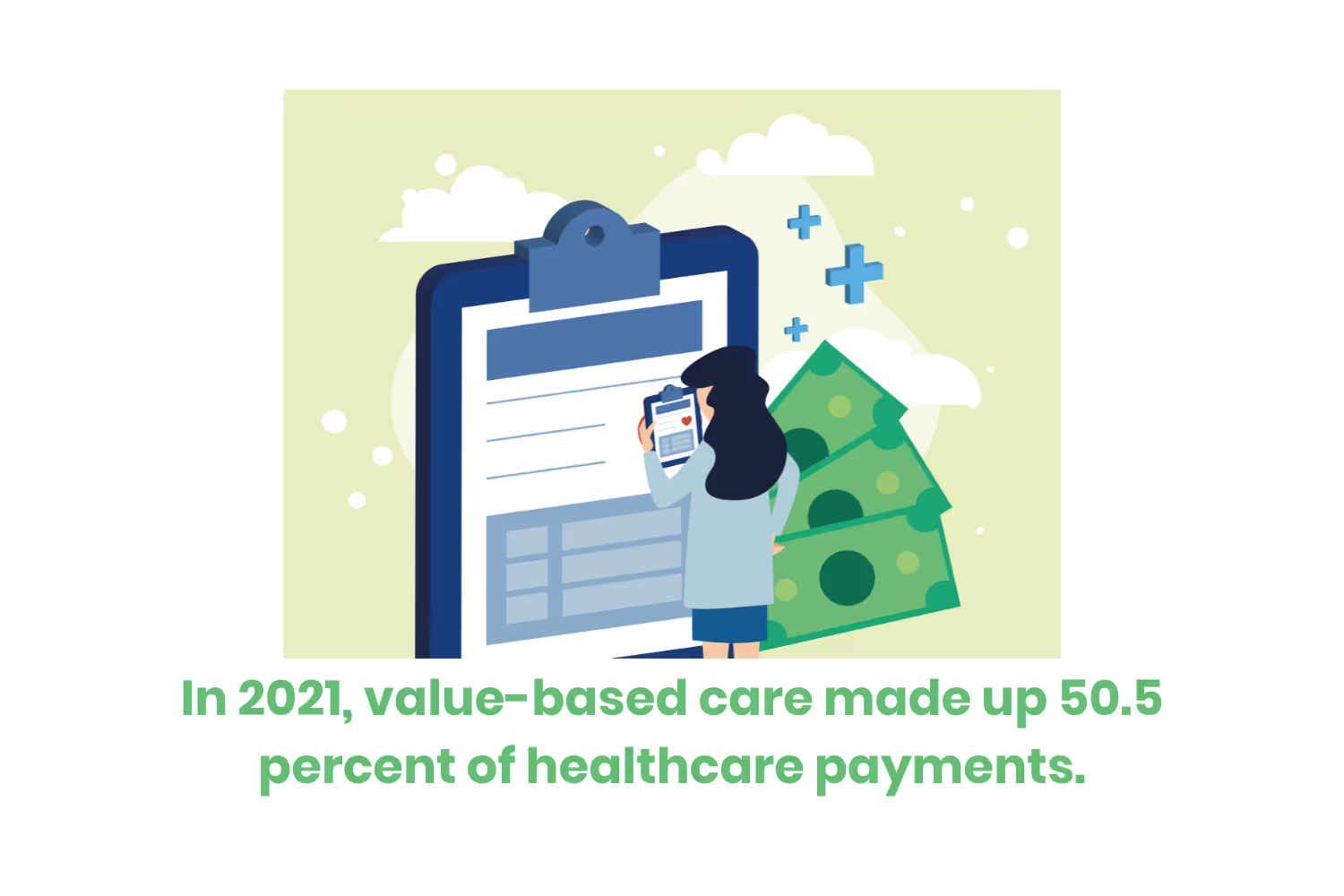[ANSWERED] What is a Fee for Service in Healthcare?
In this blog, we focus on unveiling the details surrounding the fee-for-service payment model. Details include what it is, how it works, as well as criticisms that surround the practice. Welcome to the convoluted world of health insurance payment models! Buckle up, this might be a bumpy ride.

In 2021, the amount of healthcare payments from the fee-for-service models equaled 40.5%. There are multiple different healthcare payment models. Each method exists to provide compensation to providers for services rendered. The models are all different in their method of reimbursing healthcare professionals, each addressing different aspects of:
- Healthcare delivery.
- Cost containment.
- Quality of care.

So the question becomes, “Why is this method popular?” After all, there are some noteworthy models other than fee-for-service. These include capitation, value-based reimbursement, and episodes of care/bundled payments. There are of course other examples, but we will get into that a bit later.
In this blog, we focus on unveiling the details surrounding the fee-for-service payment model. Details include what it is, how it works, as well as criticisms that surround the practice. Welcome to the convoluted world of health insurance payment models! Buckle up, this might be a bumpy ride.
What is Fee-for-Service?
Fee-for-service (FFS) is an example of a health insurance payment model. Let’s widen the scope even further for a moment. Health insurance payment models are different methods in which health insurance companies reimburse a physician. For the FFS method, this means a provider receives payment for each service rendered. This payment also depends on the type of service. This means each procedure and consultation holds a specific fee amount.

Many see this as rewarding healthcare providers for the volume and quantity of the services provided. This method faces heavy scrutiny for this reason, but we will get into that in more detail later. As of now, FFS is still widely used among private health insurance companies. It is also a term applied to traditional Medicare. This helps distinguish it from Medicare managed-care plans, as well as any other new payment systems there might be. So how does FFS work? I’m sure you’re relieved to know I’m about to fill you in on the steps! I won’t make you wait any longer, let’s go over it together.
Fee-For-Service Reimbursement Steps
Getting reimbursed as a physician is unfortunately not a cut-and-dry situation. As is anything in the medical billing industry, there are different hoops and roadblocks to maneuver through. These professional obstructions tend to change depending on the model of payment used. So let’s go through the steps that make up fee-for-service reimbursement and see how to avoid any of these possible setbacks.
Service Provision
FFS starts with the physician providing particular services to patients. These services range from all kinds of different procedures and treatments. Some common examples include the following:
- Office visits.
- Hospital stays.
- Therapies.
- Diagnostic tests.
- Surgeries.
- Laboratory services.
- Prescription Medication.
- Home healthcare.
- Durable Medical Equipment (DME).
- Mental health services.
Remember, each service gets billed separately from one another. This means, that the more services a physician performs under this payment model, the more money they make. The system bases payment amounts on the complexity of the services. For example, surgeries will garner a larger reimbursement than just an office visit.

Documentation & Coding
Being sure to accurately document the services provided is the next step. It is crucial to record everything performed by the provider and to make sure the documentation is as detailed as possible. For example, healthcare professionals should be sure to include the following details in each patient’s record:
- Nature of the service.
- Procedures performed.
- Relevant Diagnoses.
- The time spent on each service.
Once you update a patient’s record, it is now time to correctly code each service. Coding is helpful when it comes to describing healthcare services to payers. Services have specific code sets, which include Current Procedural Terminology (CPT) or Healthcare Common Procedure Coding System (HCPCS). By utilizing these codes, your medical billing team can ensure uniformity when it comes to working with insurance companies. Seamless communication means more accurate billing and faster reimbursements.
Billing Submission
Now that you have services correctly documented and coded, you are free to submit your bills for reimbursement. Send your bills to your payer, which might include private insurance companies or government programs (Medicare or Medicaid). There might be times when you send the bill directly to the patient for payments, depending on their coverage. Coding and billing through FFS is straightforward, which is often considered a benefit when comparing models.

Claims Processing & Adjudication
You submitted your bills to the payer and all is going well! Well, ideally it’s going well. It’s time for your bills to undergo the dreaded step of ‘claims processing’. Okay, maybe I am being a little dramatic, but if you’re in medical billing you know that this step might be the least fun of them all.
After all, if you receive a claim denial it means dealing with extended amounts of time in which your practice is not getting reimbursed for services. This can throw a wrench in your revenue cycle, so make sure you pay attention to the steps leading up to this process. It also helps to send your claims through a third-party clearinghouse first to scrub your data and let you know if any mistakes need adjusting.
After the claims process, the insurance company then determines the reimbursement amount. Payers do this by applying factors such as contractual agreements and fee schedules, among other things. After the adjudication process, payers then reimburse the provider the amount due.
Patient Responsibility & Documentation Retention
For the amount left over after receiving the insurer's payment, responsibility oftentimes falls onto the patient. Whether through copayments, deductibles, or coinsurance, providers may bill the patient for these residual amounts.
Finally, make sure as a provider you hold onto documentation of all services rendered, as well as reimbursement collected. Just in case you need this information for compliance purposes, audits, or any other inquiries.

Criticism of the Fee-For-Service Model
The health insurance payment model that is FFS seems to have a polarizing effect on the healthcare industry. Many think it is an unethical practice that encourages physicians to deliver more services to maximize their income, even if they are not necessary.
Doctors may also encourage patients to schedule repeat visits, keeping a steady flow of revenue while addressing individual services as opposed to holistic patient outcomes. Each visit might lead to new tests and medications, which the provider can use to incentivize. Fragmented care like this can impact the quality of healthcare.
Providers are also encouraged to see more patients through this method. More than they might even be able to handle. By taking a quantity-over-quality approach, with providers spending less time with patients, this can also negatively impact patient outcomes.
FFS also has the potential to negatively affect billing processes. The system is complex enough as it is. But having to work with different codes and fees for each service, many believe this can complicate things even further. Thus, a growing administrative burden is often time-consuming and financially taxing.
Of course, this isn’t to say that all providers who work through FFS operate in this way. It is just the leading concern among those in the healthcare field.

Other Healthcare Payment Models
As I went over earlier in the blog, there are other kinds of payment models in healthcare. FFS just happens to be one of the most common types of payment. Let’s take a look at some other options when talking about how healthcare providers get compensated for their services.
- Capitation: This model dictates that physicians receive a fixed payment. This payment is per member and per month, given by a health insurance company or government program, to cover all healthcare services for a patient.
- Episode of Care/Bundled Payments: One payment, under bundled payments, covers all services related to a medical episode of care. This also applies to any particular medical condition a patient might have.
- Value-Based Reimbursement: Payments rely on the quality and outcomes of care. Through this model, more specifically pay-for-performance, providers receive incentives for meeting certain quality metrics. They also receive payment based on achieving positive patient outcomes.
- Shared Savings/Risk-Sharing: Let’s go over shared savings first. Healthcare providers receive rewards for successfully reducing healthcare costs, all while improving and nurturing the quality of care. Risk-sharing involves healthcare professionals sharing in financial risks if the costs exceed established targets.
- Direct Primary Care (DPC): This model focuses on the financial relationship between providers and patients. Patients can receive a range of primary care services by paying a monthly or annual fee.
- Accountable Care Organization (ACO): A group of healthcare providers that come together for a specific patient population. The group is responsible for the quality and cost of care for their patients. They can receive payment or be at risk for financial losses based on their performance.
Conclusion
The FFS model proves to be one of the more popular methods healthcare providers use to collect reimbursements today. However, it seems like there is a slow shift happening in the industry to other models, such as value-based reimbursement.
In 2021, value-based care made up 50.5 percent of healthcare payments. In the next few years, the Centers for Medicare & Medicaid Services seek to improve the health system for providers and patients alike.
Emphasize your product's unique features or benefits to differentiate it from competitors
In nec dictum adipiscing pharetra enim etiam scelerisque dolor purus ipsum egestas cursus vulputate arcu egestas ut eu sed mollis consectetur mattis pharetra curabitur et maecenas in mattis fames consectetur ipsum quis risus mauris aliquam ornare nisl purus at ipsum nulla accumsan consectetur vestibulum suspendisse aliquam condimentum scelerisque lacinia pellentesque vestibulum condimentum turpis ligula pharetra dictum sapien facilisis sapien at sagittis et cursus congue.
- Pharetra curabitur et maecenas in mattis fames consectetur ipsum quis risus.
- Justo urna nisi auctor consequat consectetur dolor lectus blandit.
- Eget egestas volutpat lacinia vestibulum vitae mattis hendrerit.
- Ornare elit odio tellus orci bibendum dictum id sem congue enim amet diam.
Incorporate statistics or specific numbers to highlight the effectiveness or popularity of your offering
Convallis pellentesque ullamcorper sapien sed tristique fermentum proin amet quam tincidunt feugiat vitae neque quisque odio ut pellentesque ac mauris eget lectus. Pretium arcu turpis lacus sapien sit at eu sapien duis magna nunc nibh nam non ut nibh ultrices ultrices elementum egestas enim nisl sed cursus pellentesque sit dignissim enim euismod sit et convallis sed pelis viverra quam at nisl sit pharetra enim nisl nec vestibulum posuere in volutpat sed blandit neque risus.

Use time-sensitive language to encourage immediate action, such as "Limited Time Offer
Feugiat vitae neque quisque odio ut pellentesque ac mauris eget lectus. Pretium arcu turpis lacus sapien sit at eu sapien duis magna nunc nibh nam non ut nibh ultrices ultrices elementum egestas enim nisl sed cursus pellentesque sit dignissim enim euismod sit et convallis sed pelis viverra quam at nisl sit pharetra enim nisl nec vestibulum posuere in volutpat sed blandit neque risus.
- Pharetra curabitur et maecenas in mattis fames consectetur ipsum quis risus.
- Justo urna nisi auctor consequat consectetur dolor lectus blandit.
- Eget egestas volutpat lacinia vestibulum vitae mattis hendrerit.
- Ornare elit odio tellus orci bibendum dictum id sem congue enim amet diam.
Address customer pain points directly by showing how your product solves their problems
Feugiat vitae neque quisque odio ut pellentesque ac mauris eget lectus. Pretium arcu turpis lacus sapien sit at eu sapien duis magna nunc nibh nam non ut nibh ultrices ultrices elementum egestas enim nisl sed cursus pellentesque sit dignissim enim euismod sit et convallis sed pelis viverra quam at nisl sit pharetra enim nisl nec vestibulum posuere in volutpat sed blandit neque risus.
Vel etiam vel amet aenean eget in habitasse nunc duis tellus sem turpis risus aliquam ac volutpat tellus eu faucibus ullamcorper.
Tailor titles to your ideal customer segment using phrases like "Designed for Busy Professionals
Sed pretium id nibh id sit felis vitae volutpat volutpat adipiscing at sodales neque lectus mi phasellus commodo at elit suspendisse ornare faucibus lectus purus viverra in nec aliquet commodo et sed sed nisi tempor mi pellentesque arcu viverra pretium duis enim vulputate dignissim etiam ultrices vitae neque urna proin nibh diam turpis augue lacus.



![[ANSWERED] What is a Long-Term Care (LTC) Pharmacy](https://cdn.prod.website-files.com/67e2b8210878abcba6f91ae6/68d687806a075a1cf64659b0_WhatisLongTermCarePharmacy_925.avif)
